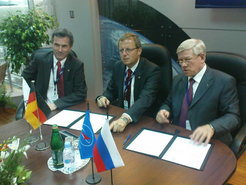eROSITA News
22 October 2019: eROSITA First Light!
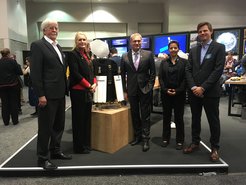
From left: Fritz Schrey, MPE, Prof Dr Ehrenfreund, DLR chairperson, Dr-Ing Walther Pelzer, chair DLR space flight management, Dr Anke Pagels-Kerp, Head of department Extraterrestrics at DLR, Dr Thomas Mernik, eROSITA project management at DLR.
04/2019 Project News: eROSITA Arrives at Baikonur
On April 25, 2019, the Spektr-RG (SRG) space observatory was transported to the Baikonur Cosmodrome - the final stage in preparation to its launch on June 21. In Baikonur, SRG will be subject to final ground tests, and will be integrated into the launch vehicle. The launch is planned with a Proton-M rocket and DM03 upper stage. Members of the eROSITA team will carry out final tests and preparations for launch at the beginning of May.
In addition to eROSITA, Spektr-RG also carries the Russian telescope “ART-XC”. Both instruments will fly from the Russian launch site Baikonur in Kazakhstan with a rocket to the second Lagrange point (L2) of the Sun-Earth system. Leaving Earth behind, eROSITA will then travel to the second Lagrange point (L2) of the Sun-Earth system, at a distance of about 1.5 million kilometres. Over a period of four years, eROSITA will carry out a total of eight scans of the entire sky to measure about 100,000 galaxy clusters, find about three million supermassive black holes and make many other interesting discoveries. This new sky survey, with much improved energy resolution and 20 times higher sensitivity than the previous one performed by ROSAT, will give scientists a closer insight into the origin and evolution of the universe.
The full press release is available here.
01/2017 Project News: A journey of a million miles begins with a single step: eROSITA travels to Russia for launch into deep space in 2018
On 20 January 2017, the completed eROSITA X-ray telescope boarded a cargo plane and was transported from Munich, where it had been built at the Max Planck Institute for Extraterrestrial Physics, to Moscow. Like any other passenger, it had to pass customs before journeying onwards towards the premises of Lavochkin Association, in the Moscow suburb of Khimki, where it is expected to arrive on 25 January. There it will be further tested and integrated with the ‘SRG’ spacecraft in preparation for launch in spring 2018. It will then take another three months to arrive at its final destination, about 1.5 million kilometres from Earth. From there, eROSITA will produce a new map of the Universe in X-rays, revealing how the largest cosmic structures evolve.
The full press release is available here.
11/2016 Project News: eROSITA leaves MPE
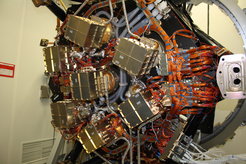
The eROSITA Flight model telescope has been fully integrated in the MPE Integration Lab. After completion of the work, on September 12, 2016, the telescope left MPE to be transported to the PANTER test facility, where it underwent an extensive end-to-end test campaign.
Here you can find a short movie that shows how the eROSITA telescope was packaged in the custom built clean container for the transport to PANTER (credit D. Coutinho).
The final test campaign on the full telescope (vibration, mass properties and EMC) will take place at IABG in Munich in December 2016. After Christmas, eROSITA will undergo customs preparation and flight security procedures, before being flown to Moscow in early January 2017.
4/2016 Project News
The final calibration of all eight Mirror Assemblies (MA = mirror module + baffle) is still ongoing in our PANTER facility, while the calibration of all Camera Assemblies (CA = filter wheel + camera + electronics) is underway in the smaller PUMA facility at MPE. In parallel, we have started the preparation for the complete telescope integration: each of the seven MA-CA pairs will be mounted first, thereby precisely adjusting the distance between mirror and camera to the individual focal lengths which has been measured during the mirror calibration.
Delivery Acceptance Review (DAR) by DLR will take place between 24.5.2016 (date of the first DAR meeting at MPE) and 23.6.2016 (DAR closure in Bonn).
More details in the eROSITA Bulletin!
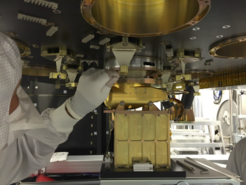
4/2016 eROSITA Bulletin, No. 7
7/2015 eROSITA Bulletin, No. 6
11/2014 eROSITA Bulletin, No. 5
10/2014 Project News
The tests with the eROSITA Technological Model performed at Lavochkin Association (LA) last October were successful. eROSITA and the S/C were able to communicate as required.
After the final recommendations of an independent review panel, the new design and manufacturing of the SRG radio-complex is underway. The medium-gain antenna will have a fixed mount and a much-increased reliability. This will enforce a change in the SRG all-sky scanning law, which will also affect the thermal profile of the telescopes, due to increased sun-avoidance angles during certain phases of the spacecraft orbit. The slight modification of the eROSITA telescope structure is underway. All other mechanical and optical subsystems are either ready or at least close to being ready.
The final calibration of the eight fully integrated Mirror Assemblies (MA) will resume early next year with the flight module cameras, immediately followed by the final integration of the MA into the telescope structure. In the meantime, the CCD-Modules are being assembled, and the progress is steady. The first Flight Model CCD (FM1) has already undergone a successful test. Most of the work now concentrates on the manufacturing and testing of the electronics: The Qualification Module of the Camera Electronics is ready and in test, the production of the FM boards has been started.
The end-to-end test of the fully integrated eROSITA telescope is scheduled for June 2015, followed by shipment to Russia. The SRG launch from Baikonour is scheduled for March 26, 2016.
02/2014 eROSITA Bulletin, No. 4
10/2013 Project News
The Spektrum Roentgen Gamma (SRG) mission preparation proceeds on all fronts. Huge progress has been made in the last six months, but, at the same time, bottlenecks in the various production and testing chains were identified, leading to a revised schedule; according to the latest plan, ART-XC will be delivered in October 2015, eROSITA in June of the same year, for a foreseeable SRG launch on March 26, 2016.
At Lavochkin Association the S/C and its subcomponents are being tested, including eROSITA and ART/XC qualification models. The production of the Zenit-2SB launcher is in progress, while the upper stage, fairing, transfer compartment are already produced. A review of the radio-complex system is underway by a team of experts from ESA, DLR, Roskosmos, Russian Academy of Science and Lavochkin Association to assess the options for SRG in light of the failure of the Phobos-GRUNT mission.
In Germany, the eROSITA X-ray telescope array continues taking shape. Currently, all eROSITA X-ray mirror shells have been produced and integrated, and the integration of the X-ray baffles into the mirror modules is also underway. The first five fully integrated flight mirror modules (two of which including baffles) were extensively tested in PANTER. With a mean HEW of 16.3’’ at 1.5keV and on-axis effective areas larger than 380 cm2 (per mirror module), they fulfill the specifications. In the meantime, Electron Deflectors, Filter Wheels, E-Box Radiators, Camera Radiators, Heatpipe System Camera, Heatpipe System Electronics are ready or in the final testing phases. All the Electronics for the on-board cameras are in production and testing phases, and they represent the last, and more time-consuming, missing element for the final assembly of the telescope. On October 14-16 more than 80 scientists met at MPE in Garching for the yearly German eROSITA Consortium meeting to discuss the progress of the activities and the prospects for the scientific exploitation of the eROSITA data.
05/2013 eROSITA Bulletin, No. 3
11/2012 eROSITA Bulletin, No. 2
12.07.2012: Second International Spectrum-RG/eROSITA conference

The Second International Spectrum-RG/eROSITA conference will take place next September,3-7th, in Kazan (Russia). The goal of the conference is to discuss the different scientific topics addressed by the mission, synergies with surveys at other wavelengths, and requirements to follow-up observations. Contributed talks and poster presentations are invited on the topics related to the SRG science goals.
About a hundred participants have already registered. An extensive scientific and cultural program is planned. There is still time to obtain Russian visas, the LOC is actively supporting participants in this process. If you are going to take part in the conference, please visit the web-page http://hea.iki.rssi.ru/kazan2012/ and register before July 20th
07/2012 eROSITA Bulletin, No. 1
19.10.2011: Agreement on eROSITA data reached
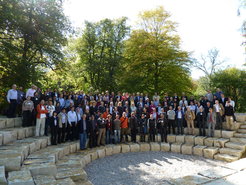
10.08.2011: eROSITA flyer "Searching for Dark Energy"

eROSITA in a nutshell: "Every Thing You Always Wanted to Know About eROSITA, but were afraid to ask" (science goals, instrument, satellite and partners)
download flyer (pdf)

